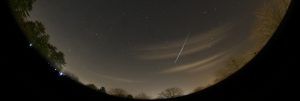
An analysis of the Geminids 2017 based on visual meteor observations is presented. A ZHR profile has been computed based on observations reported to the website of the International Meteor Organization and data from observers that were sent directly to the author.
This article provides an overview of the method, the difficulties and the final results of this analysis. The results from 2017 were also compared with old analyzes of the Geminids from 1985, 2001 and 2009.
1 Introduction
The Geminids of 2017 have been looked forward to for years. After all, [1,2,3] the parent body of the Geminids, 3200 Phaethon, would have had its closest approach in 2017 and just around the Geminids maximum. According to Galina Ryabova and Juergen Rendtel [3] there was a very small chance of some increased activity on December 14 just after 12 UT (λ 262.45 ± 0.005). Furthermore, Galina and Juergen state in the same article that the Geminid activity has increased in the period 1985-2016.
In addition, it is true that [1,2] states that the Geminids series 1985-2001-2009 and 2017 are the best returns to see if the Geminids activity increases, remains stable or decreases.
Unfortunately, the Geminid maximum in the BeNeLux was not a success. The weather was pretty bad and again it was proven that the best opportunities for clear skies were in the southern part of the BeNeLux. Of course we also looked at data from well-known observers provided via the IMO site. However, it could also be seen that the weather in 2017 had a negative impact on the observational results.
At the IMO site [4], up to 14 January 2018, 8568 different meteors were reported by 71 different observers. This resulted in the figures 1 and 2, the well-known “on the fly” curves. In this article an overview of the results from 2017 will be compared with older returns of 1985-2001 and 2009.
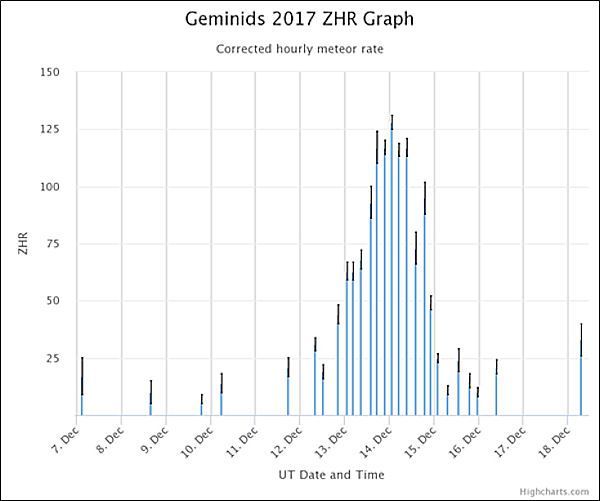 Figure 1. On the fly ZHR curve of the Geminids 2017. The curve is based on 8568 Geminids and an assumed population index r 2.6.
Figure 1. On the fly ZHR curve of the Geminids 2017. The curve is based on 8568 Geminids and an assumed population index r 2.6.
Furthermore, only data with a limiting magnitude of +5.0 or higher was used.
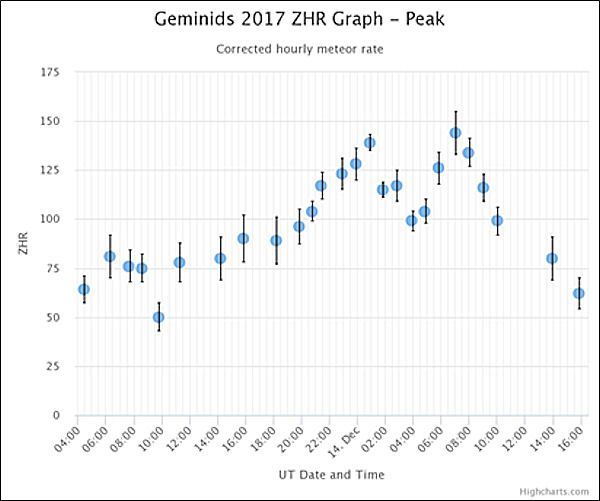
Figure 2. This ZHR curve is zoomed in on the maximum of the Geminids between 13 December 2017 4:00 UT and 14 December 2017 14:00 UT.
The curve is based on 6065 Geminids and an assumed population index r of 2.4.
Furthermore, only data with a limiting magnitude of +5.5 or higher was used. This immediately yields a better result compared to figure 1.
2 Assessment of the data
Because the weather in the BeNeLux was disappointing and because we wanted to look at the results on a global scale, we looked at the data that was reported to IMO. In addition, some observers sent their data directly to the author. Because few data were available from the observers with a reliable Cp determination, an attempt was first made to make an analysis with data from all observers with a limiting magnitude of +5.9 or higher and with an overall percentage of obstruction of no more than 10%. Also radiant heights below 25 degrees were not used. This data was then stored in the well-known ZHR spreadsheet (the interval counts) and the magnitude distribution check sheet (for the population index r determination). During the collection of the data it turned out that a large part of the observations were rather fragmented. Many observers had to deal with varying circumstances or could only observe a short period. When everything was in the spreadsheets, 6588 Geminids were used for the analysis. This is roughly 70% of all data reported to IMO.
3 Determination of the population index r
Determining a profile for the population index r turned out to be an impossible task. Only data from experienced observers is used here. The control of the magnitude distributions indicated that only 20% (!) of the submitted data of 3189 Geminids was suitable for the calculation of r-values. The rule in this spreadsheet is that the difference between the average magnitude of the Geminids and the limiting magnitude may not be greater than 4 magnitudes. This number (~ 700) of meteors is far too little for a reliable determination of the r value profile. In spite of that we tried to get a good picture of the Geminids 2017. Therefore we decided to maintain an r value of 2.5 to λ 262.2 for the ZHR calculations and to maintain a value of 2.3 after that point. This makes it possible to compare directly with the ZHR curves from the series 1985, 2001 and 2009, since in the large Geminids analysis [1] calculations were also made with those r values up to / from the same solar longitude.
4 ZHR calculations
In first instance, all data from all observers who submitted observations that met the requirements set out in point 2 were used for ZHR calculations. Observers with a known Cp were selected, while for observers with no known Cp, a Cp of 1.0 was maintained. As stated in 3, a population index r value of 2.5 was assumed for observations done before λ 262.2, followed after λ 262.2 by a population index r of 2.3. This resulted in figure 3.
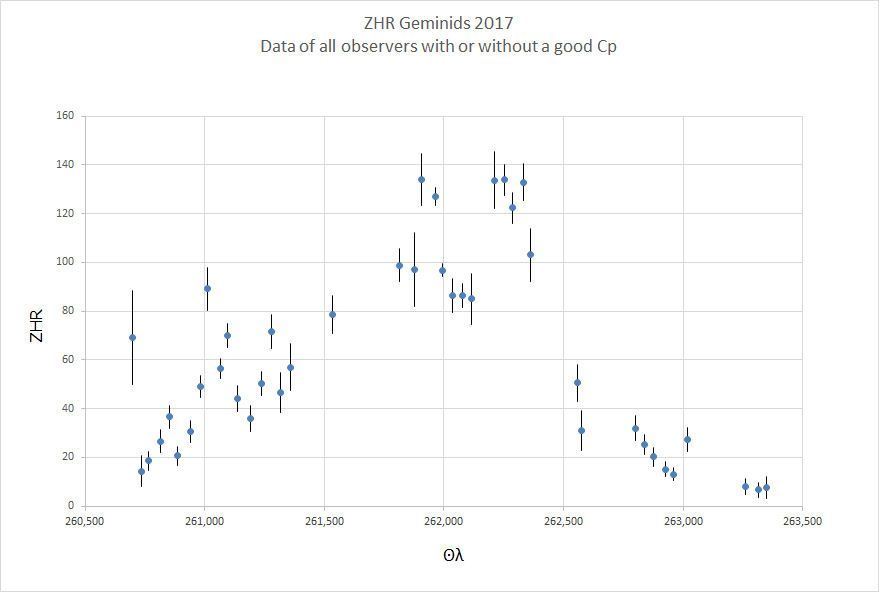
Figure 3. Geminids 2017 ZHR curve based on all observers with a minimum limiting magnitude of +5.9.
This curve is based on 6443 Geminids with an assumed population index value of 2.5 before λ = 262.2 and 2.3 after λ = 262.2.
The two visible peaks of Figure 2 on the IMO site are also clearly visible here, both with a peak ZHR of just less than 140. Furthermore, the high ZHRs obtained above Europe and the US from the night 12/13 December 2017, with peaks at λ 261.1 (13 December 2017 4.3 UT, ZHR 70) and 261.3 (13 December 2017 8.6 UT, ZHR 70) and two strong outliers at λ 260.7 (12 December 2017 18.9 UT, ZHR 70) and λ 261.0 (13 December 2017 02.3 UT, ZHR 90!).
Because of the mentioned outliers, the rather messy build up in the night 12/13 December and the rather high ZHR values that night the author zoomed in on the data gathered between λ 260.7 and 261.5. Usually there is a fairly regular build-up of activity around that solar longitude, with the ZHR slowly increasing. Further inspection of the observations shows that there seems to be a problem with the data of one observer, for who a good cp determination is available (surprisingly enough). This observer has very high individual ZHR values for the night 12/13 December, just over 100! His Cp was once determined at 0.7 (found from the period 2014-2015). To be sure, I have recalculated his Cp and added it with data from August 2017. Indeed the cp is now a bit higher with 0.9. But even then I still found high ZHR values between 70-90. The observer observed ZHR values that are twice as high compared to those of other observers with a good Cp, observing at the same time.
That is why I decided to do another complete ZHR analysis in which data was used according to the following method:
- All data from observers without a reliable Cp determination were removed.
- All data from the observer with the very high ZHR values of 12/13 December 2017 were removed, this observer could only observe the night 12/13 December. The high ZHR outlier of λ 261.011 immediately disappeared.
- The high ZHR at λ 260.70 was removed; this was an observation by one observer for who the CP was well known, an outlier.
Of the 6565 Geminids mentioned, 3995 then remained. From these data a new ZHR curve was made, the result is displayed in figure 4. It is immediately apparent that the structure of 12/13 December looks a lot more “stable”. The double peak remains, even though the first peak has been reduced by 1 ZHR point. Figure 5 is a combination of Figures 3 (ZHR curve of all observers) and 4 (ZHR curve based only on data of observers with a known CP) to better emphasize the differences.
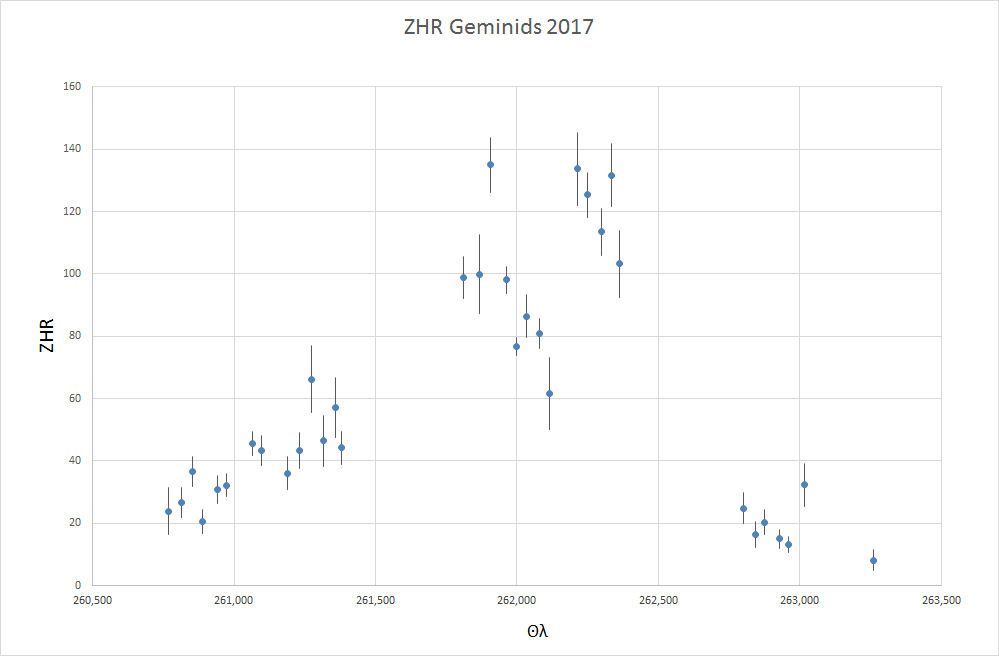
Figure 4. ZHR profile for the Geminids 2017 based on 3995 Geminids.
This is the final version of the 2017 ZHR profile for the Geminids and is the bases to compare with 1985, 2001 and 2009.
This shows again that for a good accurate ZHR determination, only data from observers with a good Cp determination must be used. One cannot throw data into one pile without controlling the data and just process it. The author insists that for a good Cp determination sporadic data, collected between July 25 and the entire month of August between 0 and 4 pm local time, should be used.
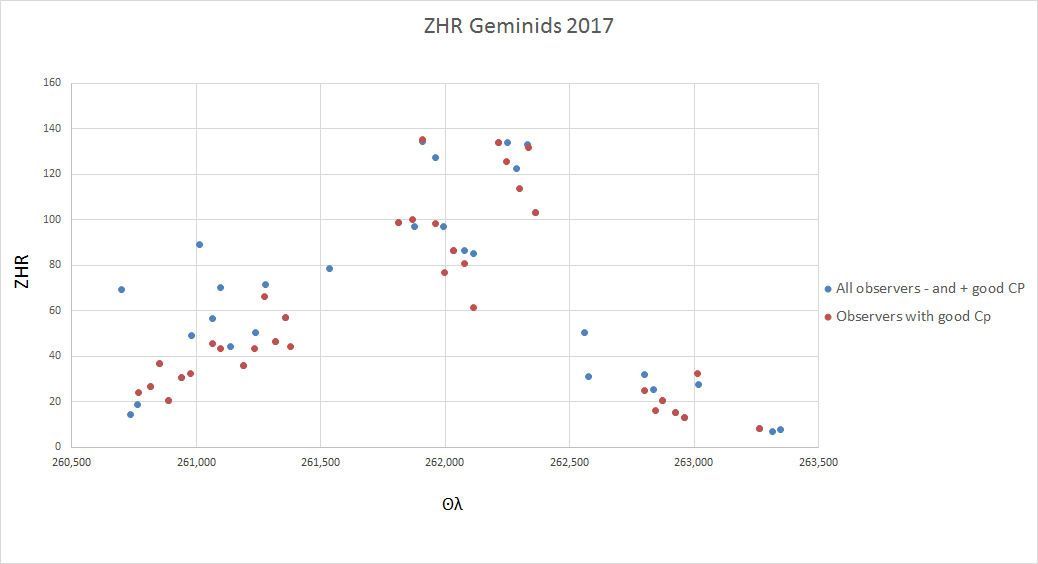
Figure 5. Comparison between ZHR profiles of figures 3 and 4.
The lower ZHRs of 12/13 December are very clearly visible; the differences in the night of 13/14 December are smaller.
5 The series 1985-2001-2009-2017
Despite the fact that most observers had moderate weather conditions during the Geminids, a “reasonable” reliable ZHR curve emerged from the calculations. It remains a pity that there was not a lot of relatively good data this year to make this analysis more robust. Nevertheless, an attempt has been made to compare the ZHR curve from 2017 with older ZHR curves. This analysis is good for comparison with the years 1985, 1993, 2001 and 2009.
For the sake of clarity, I repeat the conclusions from [1] again with regard to the series of 1985-2001- 2009.
| “To summarize: this serie is the best thing to look at the possible evolution in ZHR. It is clearly visible that 1985 was the year with the least activity in this serie. The year 2001 scores the highest in terms of ZHR and in 2009 the ZHR is a bit lower than in 2001. If the ZHR in 2017 is lower than in 2009, it is clear that we are in a downward trend of the activity of the Geminids. Then the years with the highest ZHRs are already behind us. This period with highest activity will have to be somewhere between 1996 and 2004, see also chapter 6.1”. |
1985-2017 (32 years)
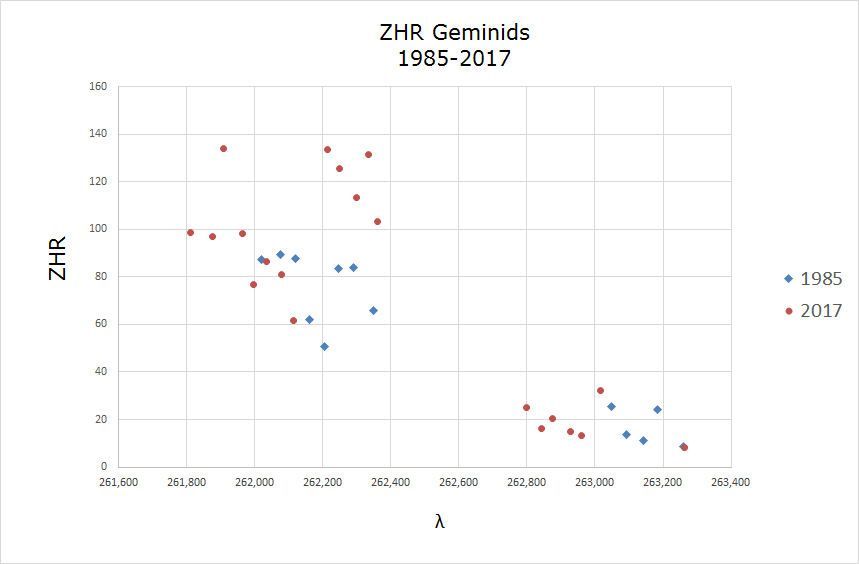
Figure 6. Comparison between the ZHR curves from 1985 and 2017. It is striking here that the ZHR in 1985 is much lower. In 1985 the author in [1,2] and Peter Jenniskens in [5] found a double peak. The ZHR curve is based on data from two good observers at one location (Puimichel, southern France), so we must also exercise caution. It would be better when more good data was available from 1985. It is also questionable to what extent the passage of a cirrus field [6] influences the “dip” between the two peaks. Furthermore, the curve seems to have shifted in solar longitude in 2017 by about 0.2 degree, earlier than in 1985. In figure 7 we have the same equation as in figure 6, but the ZHR profile for 1985 is moved forward by 0.2 degrees (= 5 hours).
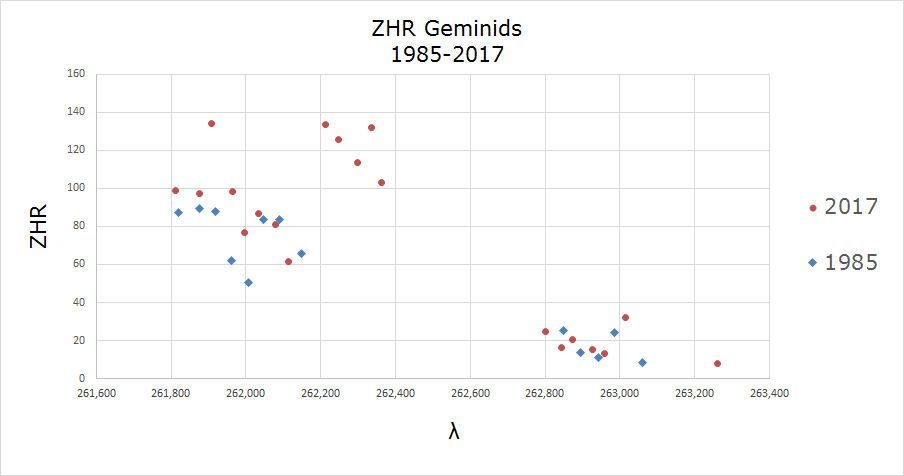
Figure 7. The same figure as figure 6, but now the ZHR profile of 1985 has been moved forward by 0.2 degrees. Really good conclusions cannot be drawn here.
The profile of 1985 is based on data from 2 observers at Puimchel (Klaas Jobse and Paul Roggemans).
No observational data is available from λ 262.2 or later on the IMO site for comparison with the peak in 2017.
2001-2017 (16 years)
Because a peak in activity above America was noticed in 2017, the author decided to look at the IMO site for observational data from known observers in the period of 14 December 2001 after 05 UT. Indeed, about seven North American observers had sent data. However, I was only able to add a limited dataset from two observers with a good Cp determination. These were Robert Lunsford (3 hours effective) and Pierre Martin (2 hours effective). Their data mutually connects nicely and is included in the figures 8 and 9 below.
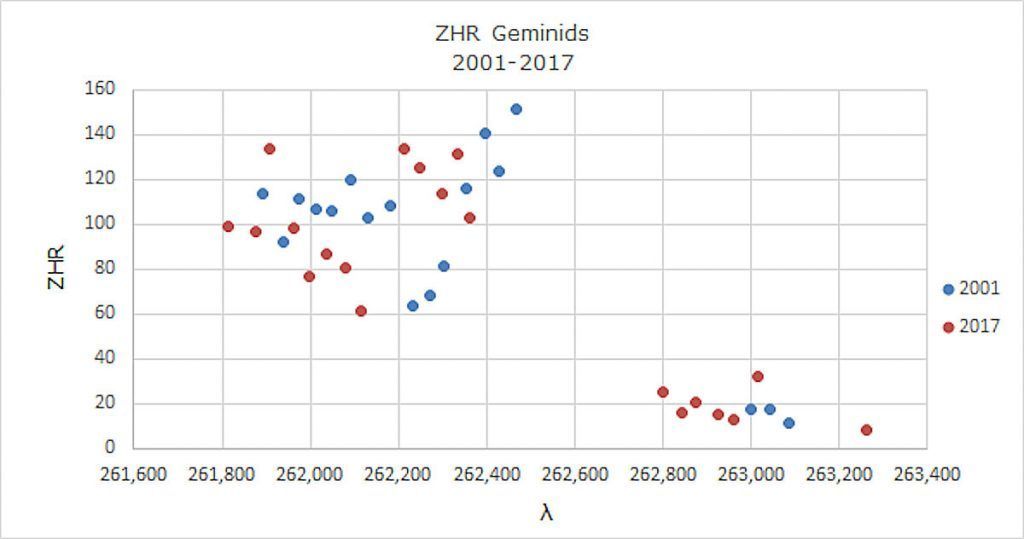
Figure 8. Comparison between the ZHR curves from 2001 and 2017. Again, the ZHR curves seem to have shifted relative to each other. M
ost of the time the ZHR from 2001 is slightly higher than 2017. Data from 2001 by Robert Lunsford and Pierre Martin has been added for comparison.
If we reset the ZHR curve from 2001 to 0.2 degrees in solar longitude, a different image is created. See figure 9 for that result.
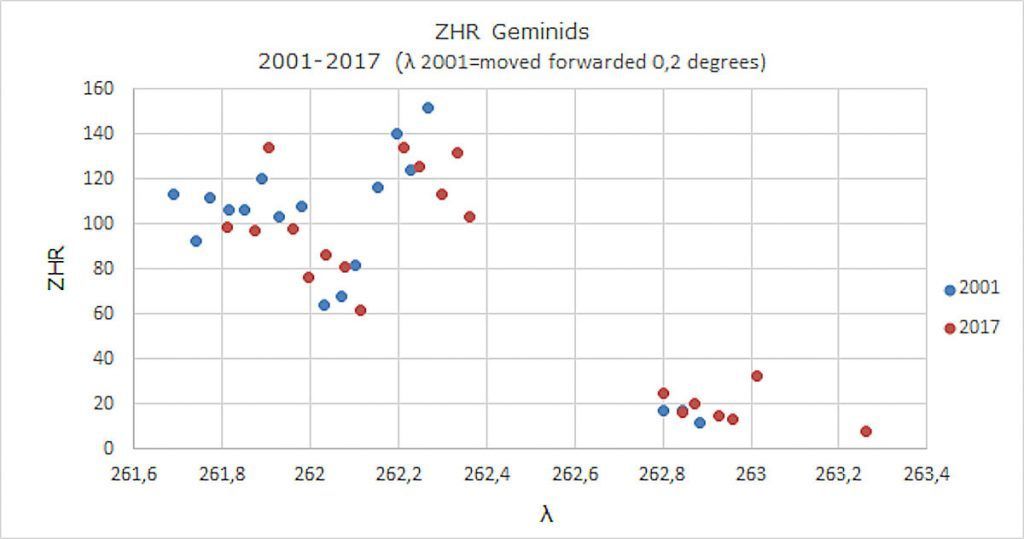
Figure 9. The same graph as figure 8, only the solar longitude of 2001 is moved forward by 0.2 degrees.
The result is remarkable; there is suddenly a reasonable agreement with each other! The second peak in 2017 was also seen in 2001 from the US.
Based on the data, we may conclude that the 2017 curve shows a slightly lower level than 2001.
2009-2017 (8 years)
Here too it was checked whether North American data could be added to the 2009 ZHR curve. It is there but it is all very brief. Only Wesley Stone has a nice set of data available, but unfortunately he had varying weather conditions, which often means that too high sky coverage percentages were reported. So his data of that night were not used.
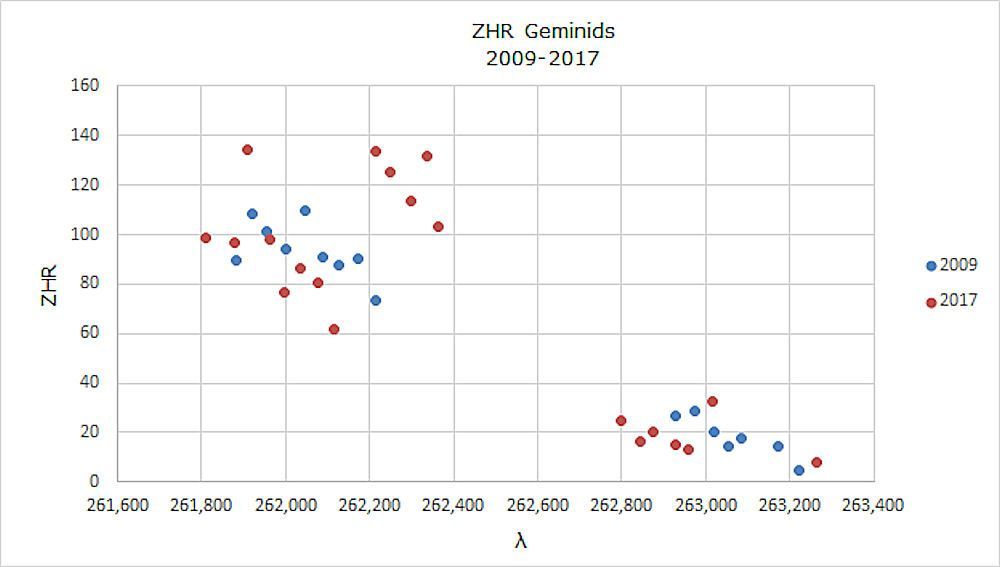
Figure 10. ZHR comparison between the Geminids of 2009 and 2016. The ZHR appears to be about 10% lower in 2017 compared with 2009.
The points after 262,200 almost all appear outside the 2009 curve. If we apply the same method (shifting the solar longitude) as in the previous
series 1985-2017 and 2001-2017, a different picture emerges. It also turns out that a shift of the 2009 curve by 0.1 degree (instead of the 0.2 degree
of the previous two series) forward with respect to 2017 gives the best fit. The result is displayed in figure 11.
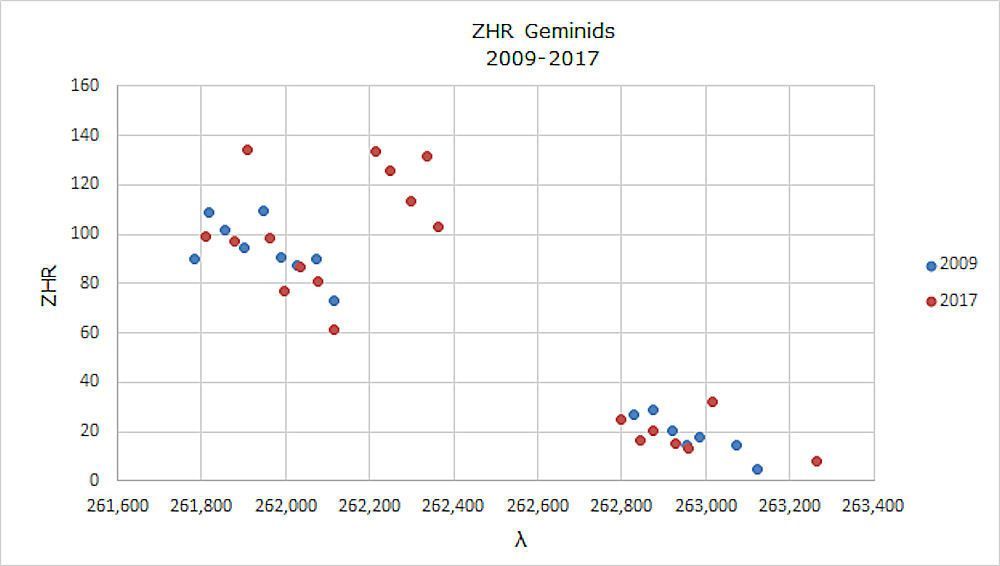
Figure 11. The same figure as figure 10. The solar longitude from 2009 has been moved forward by 0.1 degrees with respect to 2017.
Again a striking resemblance occurs. Just as with the comparison from the 2001-2017 series, the high activity in 2017 after 262,200 drops outside
the 2009 observation window. The reason is because the 2017 data also contains data from the US.
6 Some very cautious conclusions and recommendations!
- This analysis clearly showed that there are two peaks, one around λ 261.9 and the second around 262.2. In addition, there seems to be a shift in the time of the maximum in 2017 by 0.1 degree (= ~ 2.5 hours) earlier compared to 2009, 0.2 degree earlier compared to 2001 and 0.2 degree compared to 1985. That the ZHR profile varies in intensity (the height of the ZHR) is purely depending on the density of the dust trail, but the time in solar longitude is constant for all swarms over a longer period of time. If there is a real shift of ~ 0.1 ° after ~ 10 to 20 years then there must be a physical explanation for this. In the analysis of 2011, a shift of 0.1° and 0.05° is mentioned. In the case of the Geminids with a short orbital period, a course or regression of the center of the swarm with respect to the orbit of the Earth could sometimes manifest itself in this observed shift. That must be consistent, and not forward in one year and the next year backwards. Between 2017 and 2009 are 8 years with a slide of the 2009 profile 0.1° backwards in solar longitude, the profile of 2001 was shifted 0.2 ° backwards in solar longitude (16 years), but the profile of 1985 appears also to be shifted by only 0.2° in solar longitude during 32 years. If there is a regression of the core of the swarm then it is probably constant and slightly less than 0.1 ° between 2009 and 2017, also slightly less than 0.2 ° between 2001 and 2017 and just over 0.2 ° between 1985 and 2017. More good observing data obtained during the Geminids maximum in the coming years could provide more clarity here.
- It is interesting to find out if there is mass sorting at both peaks. This is certainly the case immediately after the second peak around 262.2. It is unfortunate that the observations of 2017 are so fragmented; otherwise perhaps something could have been said about the first peak. There is a short period between the two peaks with considerably lower activity. This can easily be 40 to 50% lower than the peak activity. This seems to occur in all years in the series 1985-2001-2009-2017.
- A cautious comparison between 1985, 2001, 2009 and 2017 shows that the activity in 2017 was about 10-20% higher than in 1985, 10% lower than in 2001 and 5 to 10% lower than in 2009. The difference between 2001 and 2009 is slightly larger. However, the differences are small and mostly fall within the error margins. Unfortunately, the differences are too small to speak of a clear decrease in activity of the Geminids since 2001/2004.
- However it is very clear that based on visual observations, the maximum activity of the Geminids has NOT risen in the last 15 years. This in contrast to the claim in [3]. Successful Geminid campaigns worldwide in 2018, 2020 and 2023 could perhaps provide a little more insight into this. The use of “moonlight data” is not recommended.
- Whether the parent body of the Geminids 3200 Phaethon caused extra activity in 2017 at λ 262.45 ± 0.005 (14 December 2017 12.1 UT) is very unlikely. Extra activity is not been observed by visual observers because there are no visual observations of around 14 December 2017 12.1 UT. The nearest dataset is from Terrence Ross of December 14, 2017 around 10 UT: they show no strange things, a ZHR of 110 was then observed with a magnitude distribution that looks normal. The radio data collected by the Japanese shows nothing strange around λ 262.45 ± 0.005 (see figure 12). This curve is based on worldwide radio data collected by the RMOB, see also http://www.rmob.org/livedata/main.php
- Again, this troublesome analysis has shown that only data from observers with a reliable Cp determination are eligible for use for a good ZHR analysis. It would be very nice if more observers would observe more often (preferably 15 hours effective or more) in the period from 25 July to the end of August from 0 to 4 hours local time. The more good data is used, the better the analyzes and results will be!
 Figure 12. Radio data Geminids 2017. There is no increased activity at λ 262.45 ± 0.005.
Figure 12. Radio data Geminids 2017. There is no increased activity at λ 262.45 ± 0.005.
7 Acknowledgments
The author thanks all observers who have observed the Geminids of 2017. This is not easy in cold winter conditions and therefore a lot of thanks for the commitment! In addition, the author thanks Michel Vandeputte, Paul Roggemans and Carl Johannink for their valuable contributions and suggestions. Also thanks to Paul Roggemans for checking my English.
The following observers sent their data to IMO or to the author personally: José Alvarellos, Steve Brown, Jean Francois Coliac, Kelly de Lima Gleici, Michel Deconinck, Katie Demetriou, Saee Dhawalikar, Jose Diaz Martinez, Valentin Diaz Parreño, Eini Shlomi, Richard Fleet, Kai Gaarder, Paul Jones, William Godley, Robin Hegenbarth, Carl Hergenrother, Gabriel Hickel, Glenn Hughes, Gerardo Jiménez López, Karoly Jonas, Jithendra joshi, Upasana Joshi, Javor Kac, Omri Katz, Siddharth Khalate, Sneha Kulkarni, Dmitrii Larin, Anna Levin, Gang Li, Joxia Li, Caslav Lukic, Robert Lunsford, Chinmay Mahajan, Jameer Manur, Odirlei Marcelo Alflen, Adam Marsh, Ken Marsh, Pierre Martin, Alastair McBeath, Frederic Merlin, Yuxi Mi, Koen Miskotte, Sirko Molau, Arash Nabizadeh Haghighi, Shreeya Nadgowda, Jos Nijland, Ana Nikolić, Vladimir Nikolić, Michael Nolle, Olech Arkadiusz, Nina Perović, Lazar popovic, Pedro Pérez Corujo, Ina Rendtel, Jurgen Rendtel, Terrence Ross, Branislav Savic, Alex Scholten, Kai Schultze, Shi Fangzheng, Rahul Shrivastava, Constantino Sigismondi, Ivan Stankovic, Wesley Stone, Tamara Tchenak, István Tepliczky, Sonal Thorve, Alexey tumanov, Shigeo Uchiyama, Peter van Leuteren, Hendrik Vandenbruane, Michel Vandeputte, Ariel Westfried, Roland Winkler, Frank Wächter, Sabine Wächter and Geng Zhao.
8 Plans for 2018-2020
A number of Dutch observers plan an observing expedition on the Pic du Midi in 2018. Others plan a hit & run action to clear weather such as in 2007 and 2009. In 2019, an almost Full Moon will be disturbing. In 2020 there are plans for an observing expedition in Oman. If anyone wants to be kept informed about these plans or if someone wants to take part in a hit & run action, please contact the author of this article.
References
[1] Miskotte K., Geminiden: 30 jaar waarnemingen (1980-2009), eRadiant 2010-6, p. 152-186
[2] Miskotte K., Johannink C., Vandeputte M., Bus P., Geminids: 30 years of observations (1980–2009)
[3] Ryabova G., Rendtel J., Increashing Geminid shower activity, Monthly Notices of the Royal Astronomical Society: Letters, Volume 475, Issue 1, 21 March 2018, Pages L77–L80, https://doi.org/10.1093/mnrasl/slx205
[4] http://www.imo.net/members/imo_live_shower?shower=GEM&year=2017
[5] Jenniskens P., De struktuur van het Geminidenmaximum, Radiant 8-3 (1986), p. 58-59.
[6] Jobse K., Geminiden 1985, 1600 visuele meteoren vanuit Puimichel, Radiant 8-1 (1986), p 15-16

